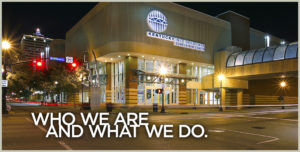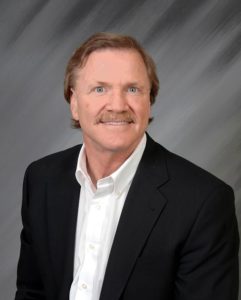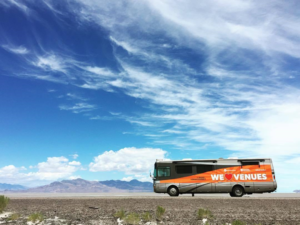Levy Convention Centers Named Exclusive Food and Beverage Provider For Kentucky International Convention Center
When the expanded and renovated Kentucky International Convention Center (KICC) reopens its doors in August of 2018, it will do so with a new food and beverage partner. Kentucky Venues has named Levy Convention Centers the exclusive concessions and catering provider for KICC and its guests.
“We’ve worked with Levy at the Kentucky Exposition Center since 2015,” said Jason Rittenberry, President and CEO of Kentucky Venues. “We share a commitment to providing exceptional service and concessions to our clients and guests, and delivering the best experience possible. With this agreement, we can bring that same level of excellence to the Convention Center.”
With a focus on local sustainability and flavors, KICC will offer an in-house garden with education sessions on the importance of Kentucky farms, carbon footprint and growing your own garden. Guests will also find an in-house bakery in addition to a flexible coffee and bourbon bar featuring a local roaster, Farmers Market style menu items, and bourbon tastings in the afternoon and evenings.
carbon footprint and growing your own garden. Guests will also find an in-house bakery in addition to a flexible coffee and bourbon bar featuring a local roaster, Farmers Market style menu items, and bourbon tastings in the afternoon and evenings.
The contract, awarded through competitive bidding by the Kentucky Finance and Administration Cabinet, takes effect July 1, 2018. The five-year contract includes a renewal option for two additional five-year periods.
“Curating localized food experiences and partnering with Kentucky farmers ensures every visitor enjoys the flavors of Kentucky,” said Andy Lansing, President and CEO of Levy. “Our dedicated culinary team will match the excitement behind the world-class renovations being made at KICC and bring the spirit of the region in a fun atmosphere.”
“Kentucky Venues is building the Kentucky International Convention Center into a true world-class building with these renovations, and we’re excited to match this dedication with an equally world-class hospitality experience,” Lansing said. “Along with the Kentucky Exposition Center, we look forward to continuing to work with Kentucky Venues to bring the unbridled spirit of the region to our guests.”
Massachusetts Convention Center Authority Issues Design and Feasibility RFP
The Massachusetts Convention Center Authority (MCCA) issued a design and feasibility Request for Proposal (RFP) for master planning services for the 70-acre campus of the Boston Convention and Exhibition Center (BCEC) in South Boston. Proposals from bidders are due back to the Authority on September 20, 2017.
Since opening in 2004, the BCEC has earned a global reputation as one of the top venues in the industry as both planners and convention guests  continue to view Boston as a prime destination to bring meetings and events which have generated billions of dollars in economic activity for the City of Boston, the Commonwealth and the region.
continue to view Boston as a prime destination to bring meetings and events which have generated billions of dollars in economic activity for the City of Boston, the Commonwealth and the region.
“It has been a dynamic and disruptive decade in our industry which has mirrored the dramatic changes that have occurred in South Boston,” said David Gibbons, executive director of the MCCA. “This is an exciting and appropriate time for the Authority to evaluate where we stand in the convention marketplace. We are asking our customers what they need and determining what we can afford in order to position the BCEC for long term success.”
The RFP will task designers to meet the needs of the BCEC’s current and future customers, better integrate the BCEC into the South Boston’s proximate neighborhoods, outline a building program that is financially self-sufficient, innovative and minimizes the impact on the environment in order to enhance the MCCA’s competitive advantage in a rapidly evolving convention marketplace.
“Boston is a premier global destination for business and tourism and the BCEC is a key catalyst to create economic activity in the city and across the region,” said John McDonnell, MCCA chairman. “The time is right to evaluate convention related growth opportunities on the BCEC campus to ensure its future success.”
IAVM Member, Pat Christenson, Publishes Book on Live Music Explosion in Las Vegas
Las Vegas. It’s been called the “Desert Oasis”, “City of Lights”, and the “Entertainment Capital of the World,” and it has been the star focus of many movies, songs, TV shows, newspaper articles, and more. For decades, Las Vegas has used entertainers to attract tourists, and to keep them coming back for more. Live music has been one of the biggest tourist attractions and has been instrumental in the growth of the city, as well as the venues that call it home.
 IAVM member, Pat Christenson, has almost four decades in developing special events in Las Vegas, and has seen the evolution of live music there from a standpoint that very few can claim. He has taken his history in the city, stories of your own venue industry peers and others, and turned it into a book so that all can now have a valuable insight into how Las Vegas became the “Live Music Capital of the World.”
IAVM member, Pat Christenson, has almost four decades in developing special events in Las Vegas, and has seen the evolution of live music there from a standpoint that very few can claim. He has taken his history in the city, stories of your own venue industry peers and others, and turned it into a book so that all can now have a valuable insight into how Las Vegas became the “Live Music Capital of the World.”
Rock Vegas: Live Music Explodes in the Neon Desert, tells the history of live entertainment in Las Vegas, but the immediate focus follows the explosion of live music in the early 90’s. Christenson, then managing the Thomas & Mack Center and Las Vegas Silver Bowl, booked every event that toured the country, averaging 175 events per year in both venues. From the front lines, he not only witnessed the opening of the floodgates that evolved Las Vegas into one of the top five live music markets in the world, but was an active participant.
It wasn’t an overnight decision to write Rock Vegas for Christenson, now the president of Las Vegas Events (LVE). “I have been involved in live music for over 35 years, and for eighteen years, at Thomas and Mack Center and Sam Boyd Stadium, I did not enjoy the show,” he admitted. “My job was to ensure fans and the bands had a good experience. At LVE, it has been working with producers to move or develop new music festivals, but I have a lot more time to go to concerts. Going to a couple dozen concerts or festivals a year gave me a fine appreciation for live music. The more I thought about it, the  more it occurred to me that no one knows how live music developed in Las Vegas. I did. However, until I got into it, I did not know how many great stories went with the evolution of live music in Las Vegas.”
more it occurred to me that no one knows how live music developed in Las Vegas. I did. However, until I got into it, I did not know how many great stories went with the evolution of live music in Las Vegas.”
“Rock Vegas gives personal and heartfelt insight of the people, politics, niche environments, and genres of music that have made Las Vegas unique and successful in the live entertainment industry,” said IAVM president, Brad Mayne. “Pat offers intriguing insights and stories of Music Icons disrupting an existing and successful business model to make way for Las Vegas to experience what other communities were already experiencing in North America.”
Rock Vegas is a book from which anyone in the venue management industry can gather many key takeaways. “I also go deeply into how crowd management, production, ticketing, social media and venues evolved,” noted Christenson. “Hopefully, they (venue managers) will get a couple of good laughs as well. A lot of their peers are in it.”
You can find and order/download Rock Vegas: Live Music Explodes in the Neon Desert online though Amazon or pick up a signed copy at VenueConnect at the MGM Resorts International at booth 156 on the Trade Show Floor!
Years of Service

Members who have reached the next milestone of their membership, 5, 10, 15, 20, etc. are receiving an updated lapel pin and wall certificate in the mail. The project is very large; it will take several weeks to complete. Right now, we are working on 2015-2017. The new brand is reflected in the letter and wall certificate. Recipients who reached this milestone in 2017 are listed on the website with the Member Tenure Recognition listing at http://iavm.org/membership-tenure-recognition. Each year, the list is updated as it reflects the year that the milestone is achieved. These members will be recognized at VenueConnect in Nashville. Thank you for your many years of membership and service! Contact Member Services at membership@iavm.org if you have any questions.
| Number of Years | Members Receiving Awards |
| 5 | 360 |
| 10 | 275 |
| 15 | 180 |
| 20 | 136 |
| 25 | 78 |
| 30 | 51 |
| 35 | 33 |
| 40 | 27 |
| 45 | 10 |
| 50 | 6 |
| 55 | 4 |
| 60 | 2 |
Road To VenueConnect: It’s All About The Face-To-Face As The RV Tour Rolls On
John Platillero, founder & CEO of EventBooking, gives a summary of his second week on the “Road to VenueConnect,” a series of workshops he and two other EventBooking staff members are hosting in 17 cities across the country. Complete with a company-branded RV, their tour of workshops will conclude at the IAVM VenueConnect conference in Nashville. There, they’ll present the insights they’ve gathered and stories from the road.
We just completed the second week of our Road To VenueConnect trip, and loving all the wonderful people we’ve met along the way. We  have logged over 3,000 miles so far, and aside from a few hubcaps falling off here or there and a lack of hot showers, the RV is holding up well. What’s even better is the fact that my traveling companions, Charlie and Kalyn, have not tossed me off the bus (yet)!
have logged over 3,000 miles so far, and aside from a few hubcaps falling off here or there and a lack of hot showers, the RV is holding up well. What’s even better is the fact that my traveling companions, Charlie and Kalyn, have not tossed me off the bus (yet)!
One truth that solidifies with each stop is that it is SO good to meet people face-to-face; to shake hands, see their venue, or in the case of Golden 1 Center—smell their venue (they program distinct scents to be emitted in each of their luxury club rooms). It has been invaluable to meet personnel in various departments and hear how they interact with each other. It’s also fascinating to hear the discussion that unfolds between venues of different types and sizes, as they discover commonalities and concerns they all share.
 One technological pain-point we’re hearing in every conversation is the fact that everyone is buried in email. It’s interesting to note that in the evolution of communication, email is what initially saved us from multiple faxes and unnecessary phone calls. In 2017, however, it’s the primary mode of business communication and can be overwhelming with multiple threads for small details. Especially in this industry, people create dozens of folders within Outlook and become experts (by necessity) at word searches to try and find what they are looking for (cue the U2 song).
One technological pain-point we’re hearing in every conversation is the fact that everyone is buried in email. It’s interesting to note that in the evolution of communication, email is what initially saved us from multiple faxes and unnecessary phone calls. In 2017, however, it’s the primary mode of business communication and can be overwhelming with multiple threads for small details. Especially in this industry, people create dozens of folders within Outlook and become experts (by necessity) at word searches to try and find what they are looking for (cue the U2 song).
Our gears are turning as a result of each discussion and we are excited to eventually return home to brainstorm ideas for how we can make everyone’s day a little better and more simple.
In the meantime, we’re making our way to Phoenix, Albuquerque, Oklahoma City, Fayetteville, Memphis and Nashville!
To join us at one of our stops, please visit here.
Do you want to receive a Front Row News weekly digest?
Categories
- Allied (861)
- Architecture (147)
- Arenas (747)
- Career (897)
- Convention Centers (895)
- Education (623)
- Events (1,544)
- Food & Beverage (193)
- Foundation (113)
- Guest Experience (1,496)
- Industry News (2,270)
- Leadership (1,888)
- Marketing (150)
- Membership (2,000)
- Music (213)
- Performing Arts Centers (454)
- Professional Development (409)
- Research (127)
- Safety & Security (442)
- Sports (763)
- Stadiums (608)
- Student (159)
- Technology (516)
- Ticketing (92)
- Touring (82)
- Trends (364)
- Uncategorized (742)
- Universities (218)
- Video (25)
- Young Professional (198)
Twitter Feed
- Twitter feed loading
Recent Posts
- Seattle Convention Center Announces Strategic Leadership Appointment and Growth Initiatives for 2026
- Peggy Daidakis Humbly Made Convention Center History
- Welcome to Our Newest Members
- New Member Benefit! IAVM Partners with Advantage Training to Elevate Staff Readiness and Guest Experience
- Charlotte Convention Center Welcomes Two New Leaders to its Management Team
Categories
- Allied
- Architecture
- Arenas
- Career
- Convention Centers
- Education
- Events
- Food & Beverage
- Foundation
- Guest Experience
- Industry News
- Leadership
- Marketing
- Membership
- Music
- Performing Arts Centers
- Professional Development
- Research
- Safety & Security
- Sports
- Stadiums
- Student
- Technology
- Ticketing
- Touring
- Trends
- Uncategorized
- Universities
- Video
- Young Professional
Archives
- December 2025
- November 2025
- October 2025
- September 2025
- August 2025
- July 2025
- June 2025
- May 2025
- April 2025
- March 2025
- February 2025
- January 2025
- December 2024
- November 2024
- October 2024
- September 2024
- August 2024
- July 2024
- June 2024
- May 2024
- April 2024
- March 2024
- February 2024
- January 2024
- December 2023
- November 2023
- October 2023
- September 2023
- August 2023
- July 2023
- June 2023
- May 2023
- April 2023
- March 2023
- February 2023
- January 2023
- December 2022
- November 2022
- October 2022
- September 2022
- August 2022
- July 2022
- June 2022
- May 2022
- April 2022
- March 2022
- February 2022
- January 2022
- December 2021
- November 2021
- October 2021
- September 2021
- August 2021
- July 2021
- June 2021
- May 2021
- April 2021
- March 2021
- February 2021
- January 2021
- December 2020
- November 2020
- October 2020
- September 2020
- August 2020
- July 2020
- June 2020
- May 2020
- April 2020
- March 2020
- February 2020
- January 2020
- December 2019
- November 2019
- October 2019
- September 2019
- August 2019
- July 2019
- June 2019
- May 2019
- April 2019
- March 2019
- February 2019
- January 2019
- December 2018
- November 2018
- October 2018
- September 2018
- August 2018
- July 2018
- June 2018
- May 2018
- April 2018
- March 2018
- February 2018
- January 2018
- December 2017
- November 2017
- October 2017
- September 2017
- August 2017
- July 2017
- June 2017
- May 2017
- April 2017
- March 2017
- February 2017
- January 2017
- December 2016
- November 2016
- October 2016
- September 2016
- August 2016
- July 2016
- June 2016
- May 2016
- April 2016
- March 2016
- February 2016
- January 2016
- December 2015
- November 2015
- October 2015
- September 2015
- August 2015
- July 2015
- June 2015
- May 2015
- April 2015
- March 2015
- February 2015
- January 2015
- December 2014
- November 2014
- October 2014
- September 2014
- August 2014
- July 2014
- June 2014
- May 2014
- April 2014
- March 2014
- February 2014
- January 2014
- December 2013
- November 2013
- October 2013
- September 2013
- August 2013
- July 2013
- June 2013
- May 2013
- April 2013
- March 2013
- February 2013
- January 2013
- May 2012
- March 2012
- December 2011
- November 2011
- October 2011
Recent Comments
- Frank Bradshaw, Ph.D., CVE on John Meyer, CVE, a Tireless Advocate of Certification for Venue Professionals, Has Died
- Neil Sulkes on Hilary Hartung, Friend to Many in Venue Marketing, Has Left Us
- Jason Parker, CVE on The Devastation of Hurricane Helene and How We Can Support One Another
- Larry Perkins on Touhey Testifies Against Speculative Ticketing Before Congressional Subcommittee
- Peter Secord on Major Players for Planned Elkhart Amphitheater Were in the Mix at VenueConnect
